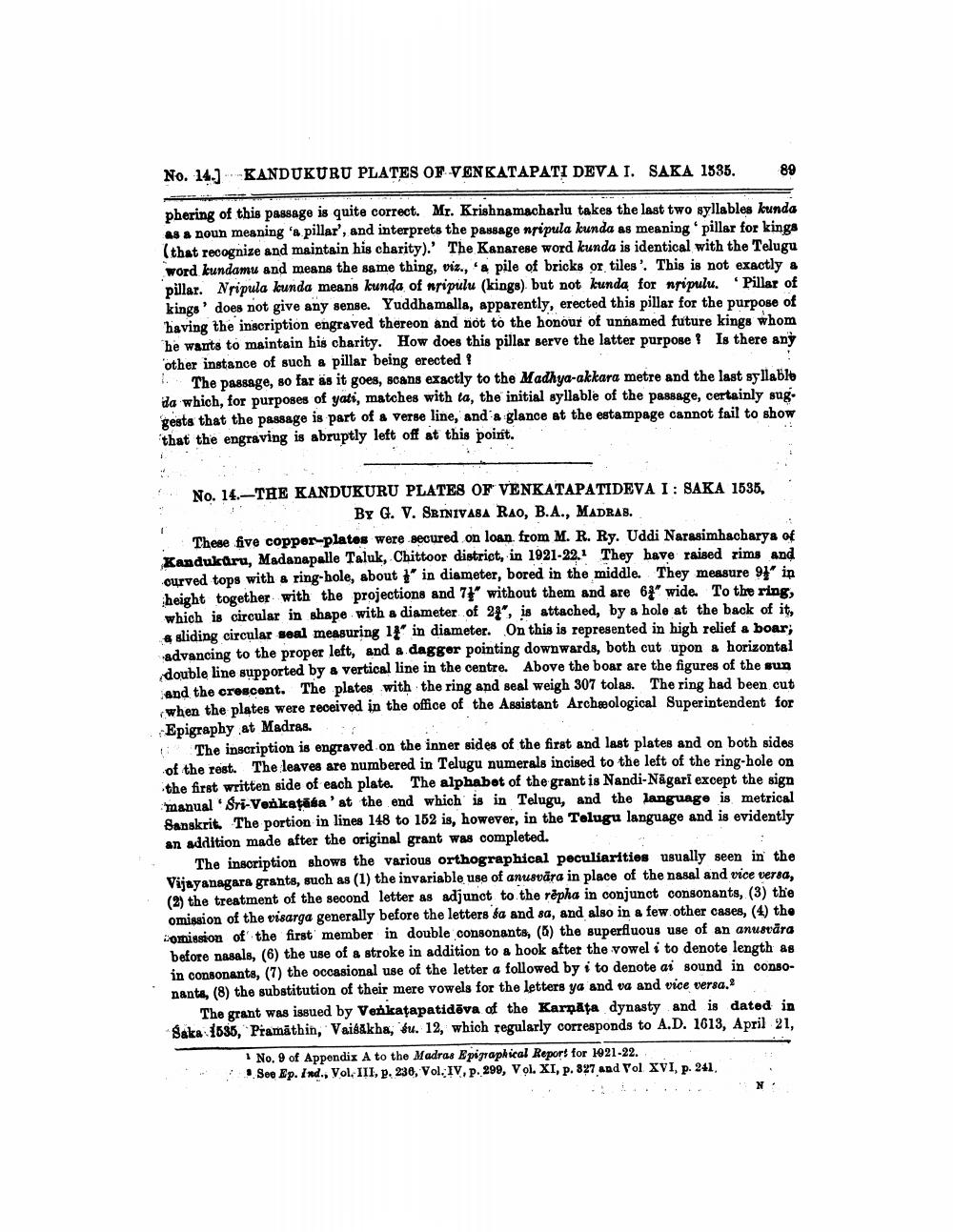________________
No. 14.) KANDUKURU PLATES OF VENKATAPATI DEVA I. SAKA 1585.
89
pbering of this passage is quite correct. Mr. Krishnamacharlu takes the last two syllables kunda as a noun meaning 'a pillar', and interprets the passage ngipula kunda as meaning pillar for kings (that recognize and maintain his charity).' The Kanarese word kunda is identical with the Telugu word kundamu and means the same thing, viz., 'a pile of bricks or tiles'. This is not exactly a pillar. Nripula kunda means kunda of npipilu (kings) but not kunda for ngipulu. Pillar of kings' does not give any sense. Yuddhamalla, apparently, erected this pillar for the purpose of 'having the inscription engraved thereon and not to the honour of unnamed future kings whom he wants to maintain his charity. How does this pillar serve the latter purpose? Is there any other instance of such a pillar being erected!
The passage, so far as it goes, scans exactly to the Madhya-akkara metre and the last syllable da which, for purposes of yati, matches with ta, the initial syllable of the passage, certainly sug gests that the passage is part of a verse line, and a glance at the estampage cannot fail to show that the engraving is abruptly left off at this point.
No. 14.-THE KANDUKURU PLATES OF VENKATAPATIDEVAI: SAKA 1535,
By G. V. SRINIVASA RAO, B.A., MADRAS. These five copper-plates were secured on loan from M. R. Ry. Uddi Narasimhacharya of Kandularu, Madanapalle Taluk, Chittoor district, in 1921-22. They have raised rims and curved tops with & ring-bole, about 3' in diameter, bored in the middle. They measure 91' in height together with the projections and 71 without them and are 6+ wide. To the ring, which is circular in shape with a diameter of 24", is attached, by a hole at the back of it,
sliding circular seal measuring 17" in diameter. On this is represented in high relief a boar; advancing to the proper left, and a dagger pointing downwards, both cut upon a horizontal double line supported by & vertical line in the centre. Above the boar are the figures of the sun and the crescent. The plates with the ring and seal weigh 307 tolas. The ring had been cut when the plates were received in the office of the Assistant Archeological Superintendent for Epigraphy at Madras.
The inscription is engraved on the inner sides of the first and last plates and on both sides of the rest. The leaves are numbered in Telugu numerals incised to the left of the ring-hole on the first written side of each plate. The alphabot of the grant is Nandi-Nagari except the sign manual. Sri Venkatāśa' at the end which is in Telugu, and the language is metrical Sanskrit. The portion in lines 148 to 152 is, however, in the Telugu language and is evidently an addition made after the original grant was completed.
The inscription shows the various orthographical peculiarities usually seen in the Vijayanagara grants, such as (1) the invariable use of anusvāra in place of the nasal and vice versa, (2) the treatment of the second letter as adjunct to the repha in conjunct consonants, (3) the omission of the visarga generally before the letters fa and 8a, and also in a few other cases, (4) the omission of the first member in double consonants, (5) the superfluous use of an anusvāra before nasals, (6) the use of a stroke in addition to a hook after the vowel i to denote length as in consonants, (7) the occasional use of the letter a followed by i to denote ai sound in consonante. (8) the substitution of their mere vowels for the letters ya and va and vice versa.
The grant was issued by Venkatapatidēva of the Karnata dynasty and is dated in Saka 1535, Pramäthin, Vaisakha, su. 12, which regularly corresponds to A.D. 1613, April 21,
No. 9 of Appendix A to the Madras Epigraphical Report for 1921-22. Soo Ep. Ind., Vol. III, p. 230, Vol. IV, p. 299, Vol. XI, p. 327 and Vol XVI, p. 241.




